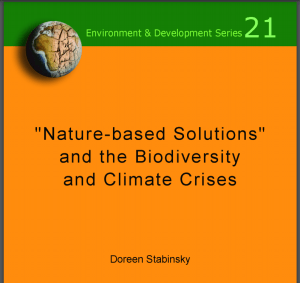
“Nature-based Solutions” and the Biodiversity and Climate Crises
from Third World Network
“Nature-based solutions” (NbS) have been defined as “actions to protect, sustainably manage and restore natural or modified ecosystems that address societal challenges…”. The societal challenge to which NbS are most commonly applied at present is the mitigation of climate change.
In this context, emissions of the greenhouse gases that cause global warming, such as carbon dioxide, are sought to be offset by safeguarding forest, soil and other ecosystems which can remove and store atmospheric carbon. While this approach has attracted corporate interest and spawned a huge market for carbon offset credits, the mitigation potential of nature is limited. To effectively counter climate change, there is thus no avoiding the need to reduce emissions to as close to zero as possible.
Despite their shortcomings, carbon markets and the NbS model have also been held out as a means of financing conservation of biological diversity. Appropriating forests and lands to serve such NbS strategies, however, threatens to dispossess the indigenous peoples and local communities who are the true stewards of the planet’s biodiversity.
In light of the dangers and drawbacks of turning to “nature-based solutions”, this paper poses the question: Whose nature is being asked to solve which problems?
CONTENTS
1. INTRODUCTION
2. THE MANY DEFINITIONS OF “NATURE-BASED SOLUTIONS
A. The genesis and evolution of the term
B. Many NbS definitions foreground climate change mitigation
C. Defining “nature” as “solution”: Whose nature? Whose solution?
3. “NET ZERO” AND NATURE
A. How “net zero” creates a need for “nature”
B. Dangerous myths and scientific realities of carbon removal
C. The scale of what nature can provide in removals
D. There is no way to zero without decarbonization
4. “NET ZERO”, CARBON OFFSET MARKETS, AND “NATURE-BASED” DECEPTIONS
5. CONNECTING THE CLIMATE AND BIODIVERSITY DOTS: IMPLICATIONS FOR BIODIVERSITY GOVERNANCE
A. Biodiversity, climate change, and geoengineering
B. Financing conservation
6. CONCLUDING THOUGHTS ON THE NATURE AND CLIMATE CRISES



